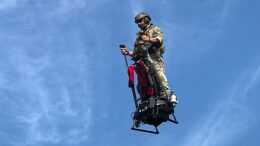by Charles Lear, author of “The Flying Saucer Investigators.”

In Last week’s blog, we looked at a case from 2023 that involved Ikitu tribe members in the village of San Antonio de Pintuyacu in Peru who reported nighttime attacks by 7-feet-tall aliens with elongated heads wearing black body armor and masks that had yellow or green eye lenses. They were said to stand of some sort of circular device like Green Goblin from the Spiderman movie that enabled them to fly and hover. Some villagers attributed the attacks to creatures from local folklore called Los Pelacaras (The Face-Peelers) said to feed on human faces and organs. Adding credence to this belief, a 15-year-old girl, identified as Talia, suffered an attack that resulted in her being taken to a hospital with lacerations on her neck. Witnesses reported that, as they came to her rescue, they saw the attackers flying away. Police came to investigate, and a spokesman for the Peruvian National Prosecutor’s office, Carlos Castro Quintanilla, came to the conclusion that illegal gold miners using jetpacks to explore deep into the jungle were responsible. This caused the story to die down in the news, but Timothy Alberino, a documentary film maker and paranormal enthusiast based in Bozeman, Montana, who had spent a good deal of time as a young man living in the jungles of Peru, returned to investigate the story first-hand and shared his findings on his YouTube site and on podcasts. While the descriptions of the creatures and the encounters were quite strange, there is a history of these sorts of reports linked to outsiders seeking to exploit natural resources in areas occupied by indigenous people, often with little concern for their rights.
 Alberino explains in his report that he “wasn’t buying” the jetpack explanation, and after receiving requests from his followers to do so, he organized an expedition to go to the village and conduct a “competent investigation.” He enlisted the aid of a friend, Doug Thornton, who was “a former infantry marine and DHS Special Response Team Operator” and contacted Brazilian UFOlogist Rony Vernet, who put him in touch with one of the villagers, a school teacher Alberino identifies as Christian, whose last name is identified in the Daily Mail as Pacaya.
Alberino explains in his report that he “wasn’t buying” the jetpack explanation, and after receiving requests from his followers to do so, he organized an expedition to go to the village and conduct a “competent investigation.” He enlisted the aid of a friend, Doug Thornton, who was “a former infantry marine and DHS Special Response Team Operator” and contacted Brazilian UFOlogist Rony Vernet, who put him in touch with one of the villagers, a school teacher Alberino identifies as Christian, whose last name is identified in the Daily Mail as Pacaya.
According to Alberino, at Pacaya’s request, he recorded a message in Spanish that Pacaya delivered to the village elders. The elders met and then replied with an official invitation to come and investigate. Alberino says Pacaya briefed him on the situation in the village at that time, which he describes as “pretty dire,” as the villagers “were still living in a heightened state of vigilance” and not going into the jungle to hunt and harvest crops. Because of this, they “were running low on critical supplies.” He was told they were still conducting nightly patrols and “still encountering the phenomenon,” though to a lesser degree.

Alberino explains that he decided his mission would be not only to investigate, but to bring provisions that would include food and medical supplies, as well as “strategic technology to support their patrols.” Alberino describes the equipment for the patrols as including radios, thermal binoculars, and night-vision goggles with the capability to record. He then thanks Pastor Darren Tyler and others from the Conduit Church in Franklin, Tennessee, who helped to provide funding for the expedition.
Along with footage of the expedition, Alberino describes arriving in Iquitos and chartering a riverboat. Along with Thornton he also had two “active-duty Navy operators” with him on the boat as well as some men from the village, including the chief, or “Apu.”
According to Alberino, they travelled for two days up the Nanay River and the Pintuyacu tributary and arrived at the village. He describes being met by “a small army of men carrying shotguns.” He greeted them from the boat, and then, he and the group went ashore with the provisions.
They were led to a government communication outpost building the villagers called “The Tombo” where they were formally greeted. They then went outside where they were treated to a native dance and given masato to drink, which is an alcoholic beverage made from yucca leaves by the women of the tribe who chew them and then allow them to ferment in their saliva. According to Alberino, “most gringos do not drink it, but those who do are received with special affection.”
After the formalities, Alberino and his group began their investigation. They visited the locations of the encounters and interviewed witnesses. He describes there being a “palpable” anxiety in the village and points out that the villagers had cut down a “huge swath” of growth to create a buffer zone between the village and the jungle, and this is shown on video. This also provided them land to plant crops so they didn’t need to venture into the jungle.
Alberino describes being surprised by the number of different villagers who “had actually encountered the so-called pelecaras,” and by the consistency of the stories. The description he gives of the assailants is similar to the ones that were in the news with the additional details that they wore small, hard-shell back packs, footwear that had two discs on the soles of each shoe that emitted a red light, and that they were extremely agile and had the ability to leap over a house in one bound.
According to Alberino, the assailants were described as surfing through the air on three-feet-diameter platforms that moved silently (except when lifting off, when they would make a sound like compressed air being released) and could move at great speed. They were said to fly to the edge of the village on the platforms, dismount, and then walk or float into the village. They were said to get back on them and fly away when they were chased out. Alberino also describes platforms that were ten feet in diameter that could hold two people. He emphasizes that whenever the assailants appeared, there were always two of them.
According to Alberino, the assailants were “also equipped with advanced aerospace technology – what we call UFOs.” They were consistently described as acorn-shaped, about as big as a private jet, with small round protrusions instead of wings that would fold out and reveal lights. These were reported to have been seen hovering over the village at altitudes as low as 30-40 feet. At one point a craft appeared to be transparent and beings could be seen sitting inside. The UFOs were said to be silent except when they accelerated, at which time they would emit a low hum.
Alberino says he and the others stayed in the village for two nights and three days, and on their last night, met with village men to teach them how to use the equipment that had been brought for them and how to hold their guns while on patrol so they didn’t shoot each other. They also put the men through maneuvers to help them “organize themselves into a now-efficient fighting force.” He describes leaving them better prepared to defend themselves and able “to capture the phenomenon on camera.”
Thornton joins Alberino and they discuss approaching Talia with the intent of interviewing her. They describe her as trembling, crying, and hiding her face upon first seeing them. Thornton describes her as displaying symptoms of PTSD and says she had been diagnosed with this by “a doctor down the river.”
They managed to interview Talia at her house the next day and Thornton describes her actually going into convulsions beforehand and that she seemed to be scared of them specifically, them being gringos. Alberino adds that half the people he talked to believed the assailants were gringos and the other half believed they were aliens (he adds later that this opinion would vacillate between the two). After Talia stood trembling in silence for about two minutes after the first question, she opened up and told the same story she told the 5-Meo team.
Alberino and Thornton discuss Talia’s attack and speculate on who or what the attackers might have been. They firmly agree that they weren’t miners with jetpacks.
Next week: flying gringos in earlier Peruvian history.
Podcast: Play in new window | Download